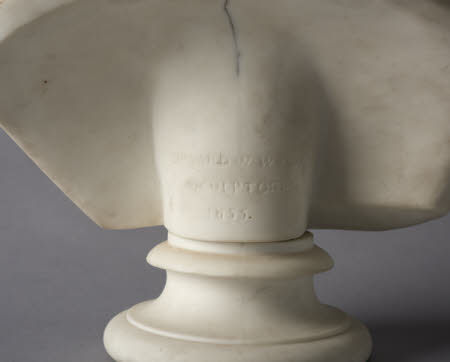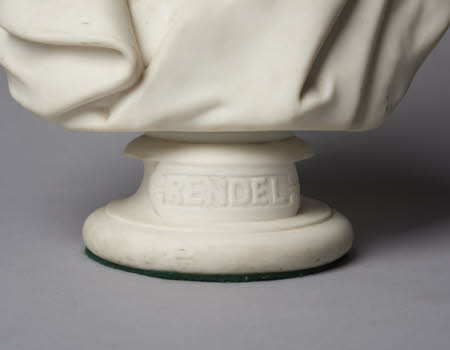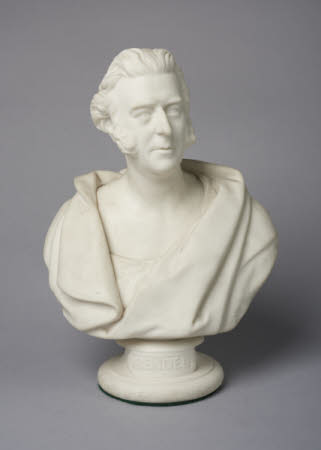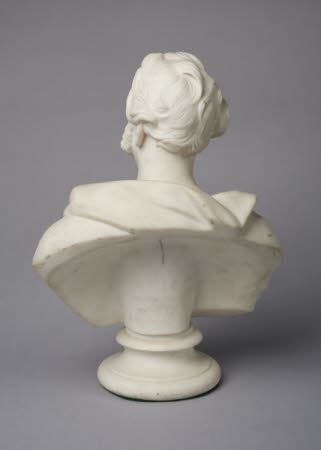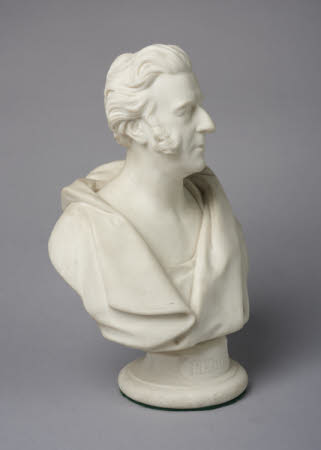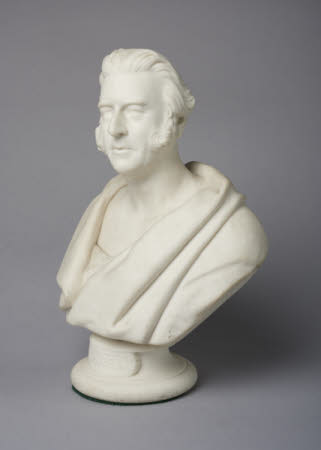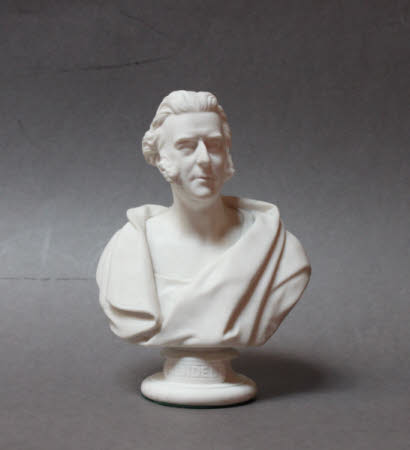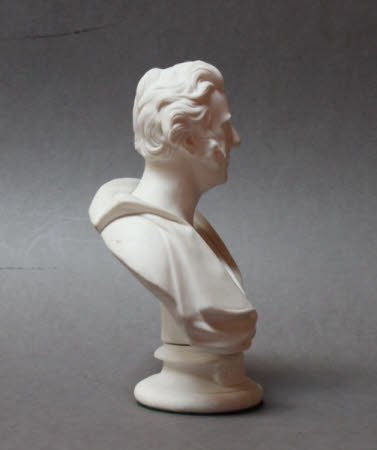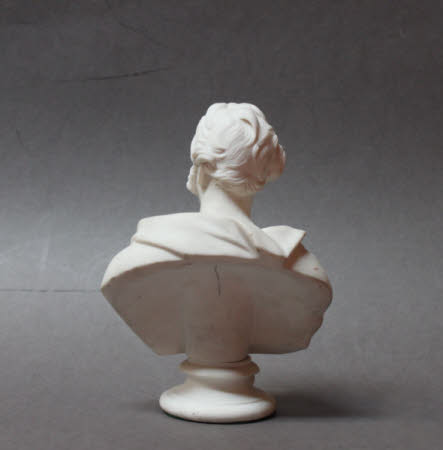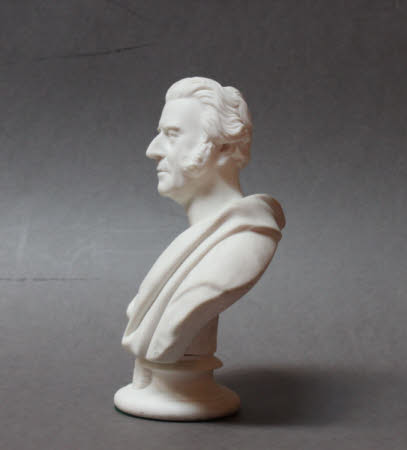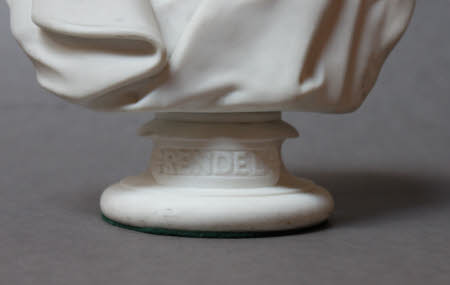Portrait bust of James Meadows Rendel, FRS (1799-1856)
after Edward William Wyon (1811 - 1885)
Category
Art / Sculpture
Date
1855 (signed and dated)
Materials
Parian ware ceramic
Measurements
267 x 185 x 133 mm
Place of origin
Stoke-on-Trent
Order this imageCollection
Cragside, Northumberland
NT 1230988
Summary
Ceramic, Parian ware; Portrait bust of James Meadows Rendel, FRS (1799-1856); Minton, after Edward William Wyon (1811-1885); 1855. A commemorative bust depicting the celebrated civil engineer James Rendel, friend and business partner of Sir William Armstrong, and father of Sir Alexander Meadows Rendel (1829 - 1918), George Wightwick Rendel (1833 - 1902) and Lord Stuart Rendel (1834 - 1913), all Armstrong associates.
Full description
A Parian ware ceramic portrait bust of the engineer James Meadows Rendel (1799-1856), showing the subject wrapped in a loose toga-like garment, looking to his left. The bust section is made separately from the socle, which bears the inscription ‘RENDEL’. James Meadows Rendel was a leading civil engineer who became a close friend and business partner of William Armstrong. Born in Devon, he worked as a young man for Thomas Telford, before beginning his professional career in Plymouth, with the building of a bridge across the river Plym. He subsequently built or assisted with the design of several suspension bridges across Britain, and also became an acknowledged authority in hydraulic engineering, improving and developing harbours across the south-west. After moving to London in 1838, Rendel became involved in dock, harbour and railway projects across Britain and eventually as far afield as South Africa and India. In 1843, James Rendel met William Armstrong when he visited Newcastle to carry out a survey of the river Tyne. Rendel believed passionately in the potential of hydraulic water power and persuaded Armstrong, then still working as a lawyer, to overcome his father’s initial objections and to begin manufacturing hydraulic machinery. The two men collaborated on a major scheme for the improvement of the docks at Grimsby, which featured hydraulically powered lock gates, sluices, and cranes and a 300 feet high hydraulic tower, which is a local landmark to this day. They became close friends; as Rendel’s son Stuart wrote: ‘the attachment between him and Armstrong became a close one, and Armstrong was a constant visitor at my father’s house whenever called to London on business.’ (Henrietta Heald, William Armstrong. Magician of the North, Newcastle-upon-Tyne 2010, pp. 49-50). The childless Armstrong all but adopted Rendel’s third son George Wightwick Rendel (1833-1902), who became a talented engineer and naval architect and joined Armstrong’s Elswick Works. After Rendel’s early death, Armstrong took personal charge of the funeral arrangements and became ever closer to his children. Rendel’s other sons Alexander Meadows Rendel (1829-1918) and Stuart Rendel, 1st Baron Rendel (1834-1913) also worked with and for Armstrong. The Parian ware bust seems to have formed part of a series of commemorative portraits of engineers produced by Minton after portraits by Edward William Wyon, the other subjects including Robert Stephenson and George Stephenson, George Parker Bidder and Sir John Fowler (Atterbury, The Parian Phenomenon, figs. 440-41). Edward William Wyon (1811-95), a member of the Wyon dynasty of die-engravers and medallists, practised as a sculptor, exhibiting at the Royal Academy over many years. A number of his portraits were designed exclusively for production in Parian ware, and it may well be that the series of engineers was conceived as one of these series. Nevertheless, Wyon made a full-size version of the portrait in marble (NT 1166742), now at Hatchlands Park. Hatchlands was bought by Stuart Rendel in 1888 and descended in the Rendel family until it was given to the National Trust in 1945. The Htachlands version, dated 1856, was probably made after Rendel’s death, and may be the marble version that was exhibited at the Art Treasures exhibition in Manchester in 1857 (Catalogue of the art treasures of the United Kingdom, collected at Manchester in 1857, Manchester 1857, p. 136, no. 138). Jeremy Warren March 2022
Provenance
Given by Miss Rendel, 1993
Marks and inscriptions
Front of socle: RENDEL Back : EDWARD W. WYON. /SCULPTOR. /1855.
Makers and roles
after Edward William Wyon (1811 - 1885), sculptor Minton's Ltd (Minton and Co.) , ceramic manufacturer
References
Atterbury, 1989: Paul Atterbury &c, The Parian Phenomenon. A Survey of Victorian Parian Porcelain statuary and busts, Somerset, 1989, p. 128, fig. 473.

